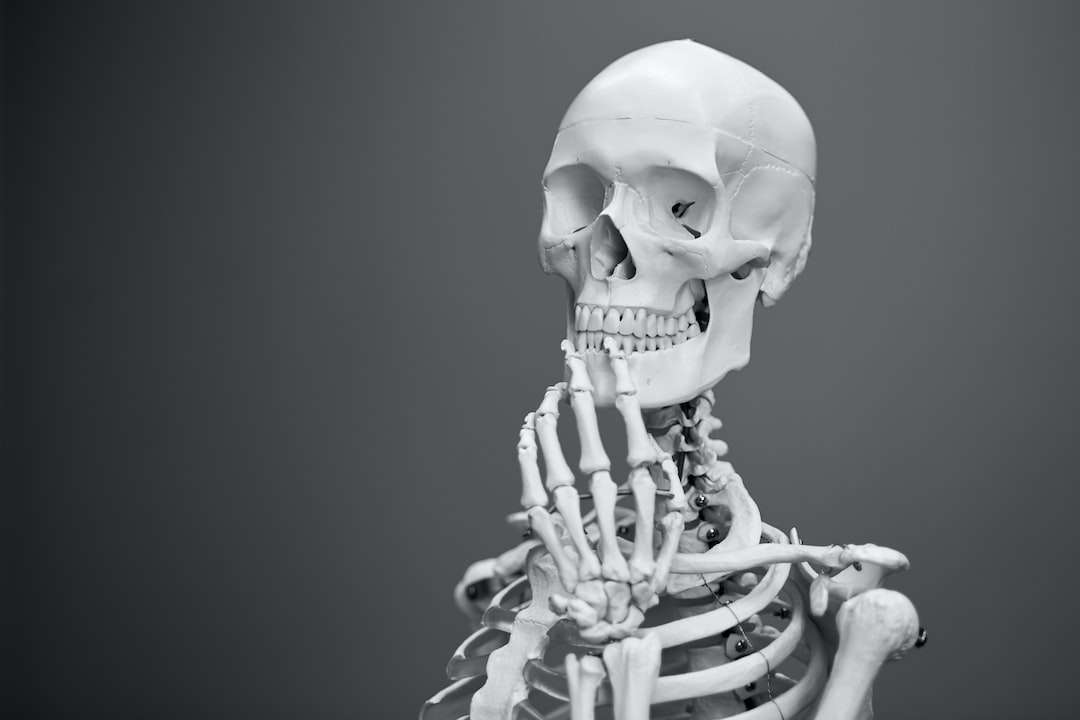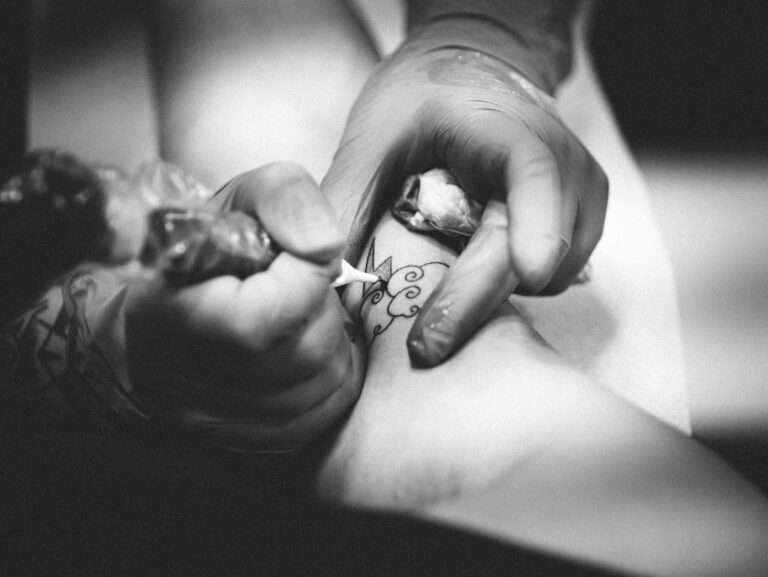The Symbolic Power of Skull Tattoos

Skull tattoos have become increasingly popular in recent years, with people from all walks of life choosing to adorn their bodies with this iconic symbol. But what is it about skull tattoos that captivates us? In this article, we will delve into the history, symbolism, cultural significance, and psychology behind skull tattoos to gain a deeper understanding of their enduring appeal.
A Brief History of Skull Tattoos: From Ancient Cultures to Modern Times
Skull tattoos have a rich and diverse history that spans across different cultures and time periods. In ancient civilizations such as the Aztecs and Egyptians, skulls were seen as symbols of death and rebirth. They were often used in rituals and ceremonies to honor the deceased and to commemorate the afterlife.
As time went on, skull tattoos evolved and took on new meanings. During the Renaissance period, skulls were commonly depicted in artwork as a reminder of the transience of life and the inevitability of death. This theme continued into the 20th century, where skull tattoos became popular among sailors and soldiers as a symbol of bravery and defiance in the face of death.
The popularity of skull tattoos skyrocketed in the modern era, thanks in part to influential tattoo artists such as Sailor Jerry and Ed Hardy. These artists helped to popularize the use of skulls in tattoo designs, making them more accessible to a wider audience.
The Symbolism of Skull Tattoos: Death, Mortality, and the Afterlife
One of the most common meanings associated with skull tattoos is death and mortality. The skull is a universal symbol of human mortality, reminding us that life is fleeting and that death is inevitable. It serves as a reminder to live life to the fullest and to appreciate every moment we have.
However, the symbolism of skull tattoos goes beyond just death and mortality. In some cultures, skulls are seen as a symbol of the afterlife and rebirth. They are believed to represent the journey of the soul from one life to the next, and are often used in religious and spiritual practices to honor and remember the deceased.
Skull tattoos can also be used to commemorate loved ones who have passed away. Many people choose to get a skull tattoo as a way to keep the memory of a loved one alive, and to honor their life and legacy. These tattoos can serve as a constant reminder of the impact that person had on their life, and can provide comfort and solace in times of grief.
Skull Tattoos in Religion and Spirituality: From Christianity to Hinduism
Skull imagery has played a significant role in various religious and spiritual practices throughout history. In Christianity, skulls are often depicted as a symbol of mortality and the transient nature of life. They serve as a reminder that we are all mortal beings, and that our time on Earth is limited.
In Buddhism, skulls are seen as a symbol of impermanence and the cycle of life and death. They represent the transient nature of existence, and serve as a reminder to live in the present moment and to let go of attachments.
In Hinduism, skulls are associated with Lord Shiva, the god of destruction and transformation. They are often depicted in artwork and sculptures as a symbol of his power and ability to destroy and create.
While skull tattoos can be used to express one’s religious or spiritual beliefs, it is important to note that the use of skull imagery in religious contexts can be controversial. Some people may find it disrespectful or offensive, while others may see it as a way to honor and connect with their faith.
The Cultural Significance of Skull Tattoos: From Pirates to Day of the Dead
Skull tattoos have long been associated with certain subcultures and cultural movements. In pirate culture, skulls were often used as symbols of fear and intimidation. Pirates would often fly flags adorned with skull and crossbones to strike fear into the hearts of their enemies.
In Mexican culture, skulls are a prominent symbol in the celebration of the Day of the Dead. This holiday, which takes place on November 1st and 2nd, is a time to honor and remember loved ones who have passed away. Skull tattoos are often used as a way to commemorate this holiday and to pay tribute to the deceased.
Skull tattoos can also be used to express one’s identity and affiliation with a particular subculture. For example, in the punk and goth subcultures, skull tattoos are often seen as a symbol of rebellion and nonconformity. They serve as a way to express one’s individuality and to reject societal norms.
However, it is important to note that skull tattoos have also been appropriated and commercialized in mainstream culture. They have become a popular design choice for clothing, accessories, and other consumer products, often losing their original meaning and cultural significance in the process.
Skull Tattoos in Art: The Symbolic Power of Skulls in Paintings and Sculptures

Skulls have long been a popular subject in art, from traditional paintings to contemporary sculptures. Artists have been drawn to the symbolic power of skulls, using them to evoke emotions and provoke thought.
In traditional paintings, skulls were often depicted as memento mori, or reminders of death. They served as a reminder that life is fleeting and that death is inevitable. Artists such as Caravaggio and Rembrandt used skulls in their artwork to explore themes of mortality and the human condition.
In contemporary art, artists such as Damien Hirst and Jean-Michel Basquiat have used skull imagery in their work to challenge societal norms and explore themes of life, death, and identity. Their use of skulls serves as a commentary on consumerism, mortality, and the human experience.
Skull tattoos can be seen as a way for individuals to carry a piece of this artistic tradition with them wherever they go. They serve as a constant reminder of the power and beauty of art, and can provide a source of inspiration and reflection.
Skull Tattoos in Pop Culture: From Music to Fashion
Skull imagery has played a significant role in popular culture, from music to fashion. Musicians such as the Rolling Stones and Guns N’ Roses have incorporated skull imagery into their album covers, stage designs, and merchandise, making it synonymous with their brand and music.
In the world of fashion, designers such as Alexander McQueen have used skull motifs in their collections to create bold and edgy designs. The skull has become a symbol of rebellion and nonconformity in the fashion industry, representing a break from traditional norms and expectations.
Skull tattoos can be seen as a way for individuals to express their fandom and affiliation with a particular cultural movement. They serve as a visual representation of one’s love for music, fashion, or any other form of popular culture.
The Psychology of Skull Tattoos: Why People Choose to Get Inked
The decision to get a skull tattoo is deeply personal and can be influenced by a variety of psychological factors. For some people, getting a skull tattoo is a way to express their individuality and uniqueness. It serves as a form of self-expression, allowing them to showcase their personality and beliefs.
For others, getting a skull tattoo is a way to confront mortality and come to terms with the inevitability of death. It serves as a reminder to live life to the fullest and to appreciate every moment we have.
Peer pressure and social norms can also play a role in the decision to get a skull tattoo. In some subcultures, such as the punk or goth scene, skull tattoos are seen as a rite of passage or a way to fit in with a particular group. People may feel pressured to get a skull tattoo in order to be accepted or to conform to societal expectations.
It is important to note that getting a tattoo, including a skull tattoo, comes with both risks and benefits. There are potential physical risks, such as infection or allergic reactions, as well as psychological risks, such as regret or dissatisfaction with the tattoo. It is important for individuals to carefully consider their decision and to choose a reputable tattoo artist who can provide guidance and support throughout the process.
The Different Styles of Skull Tattoos: Traditional, Realistic, and Abstract
Skull tattoos come in a variety of styles, each with its own unique characteristics and meanings. Traditional skull tattoos are characterized by bold lines and vibrant colors. They often feature additional elements such as roses, daggers, or banners, and are reminiscent of the classic American traditional tattoo style.
Realistic skull tattoos aim to capture the intricate details and textures of a human skull. They are often done in black and gray ink, and can be incredibly detailed and lifelike. These tattoos are popular among those who want a more realistic representation of a skull.
Abstract skull tattoos take a more artistic approach, using bold lines, geometric shapes, and vibrant colors to create a unique and eye-catching design. These tattoos are often open to interpretation and can be highly personalized.
The style of skull tattoo that an individual chooses can convey different meanings and emotions. Traditional skull tattoos may represent a connection to heritage or tradition, while realistic skull tattoos may symbolize a desire for authenticity or truth. Abstract skull tattoos may represent a more artistic or creative approach to life.
The Enduring Appeal of Skull Tattoos and What They Mean to Different People
In conclusion, skull tattoos have captivated us for centuries with their rich history, symbolism, cultural significance, and psychological appeal. From ancient civilizations to modern times, skulls have served as a reminder of our mortality and the transient nature of life.
The meaning of a skull tattoo can vary widely depending on the individual and their cultural context. For some, it may represent a connection to their heritage or a way to honor loved ones who have passed away. For others, it may be a form of self-expression or a way to confront mortality.
Skull tattoos have become an enduring symbol in popular culture, from music to fashion. They have been appropriated and commercialized, losing some of their original meaning and cultural significance in the process.
Ultimately, the appeal of skull tattoos lies in their ability to evoke emotions, provoke thought, and serve as a visual representation of our beliefs, values, and identity. They are a powerful form of self-expression that allows us to carry a piece of our history, culture, and personal journey with us wherever we go.
If you’re interested in exploring the symbolism behind skull tattoos, you might also find our article on the symbolism of the moon intriguing. The moon has long been associated with various meanings and interpretations across different cultures and belief systems. From representing femininity and intuition to symbolizing cycles and transformation, the moon holds a significant place in symbolism. To delve deeper into this fascinating topic, check out our article on the symbolism of the moon.
FAQs
What is a skull tattoo?
A skull tattoo is a design that features a human skull, either realistic or stylized, as the main element of the tattoo.
What is the meaning of a skull tattoo?
The meaning of a skull tattoo can vary depending on the individual and the culture. In some cultures, the skull is a symbol of death and mortality, while in others it can represent rebirth or transformation. Some people also get skull tattoos as a reminder to live life to the fullest.
What are some common designs for skull tattoos?
Common designs for skull tattoos include realistic skulls, sugar skulls, tribal skulls, and skull and crossbones.
What are some popular placements for skull tattoos?
Popular placements for skull tattoos include the forearm, upper arm, chest, back, and thigh.
Are skull tattoos only for men?
No, skull tattoos are not only for men. Both men and women can get skull tattoos, and there are many designs that are specifically geared towards women.
Do skull tattoos have any religious significance?
Skull tattoos can have religious significance in some cultures. For example, in Hinduism, the skull is a symbol of the god Shiva and is often used in religious rituals.
Are skull tattoos considered taboo?
Skull tattoos are not necessarily considered taboo, but they can be associated with certain subcultures or lifestyles. It is important to consider the potential social and professional implications of getting a skull tattoo before getting one.





